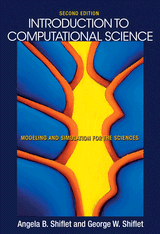Introduction to Computational Science:
Modeling and Simulation for the Sciences (Second Edition)
Angela B. Shiflet and George W. Shiflet
Wofford College
© 2014 by Princeton University Press
ISBN: 978-0-691-16071-9
REVIEWS
The Bookseller Buyer's Guide
Spring Books 2014
"The essential introductory textbook to computational science."
The UMAP Journal
First Edition Review by James M. Cargal
29.2 (2008), pp. 182-184
Excerpts from Review:
"I think this text is a masterpiece. I know of nothing comparable. I give it five stars."
"In pedagogical terms, this book is the best thing I have seen in a long time; books this good come along about once every five years."
"A great deal of work has gone into this book, and it does many things extremely well."
"It has excellent tutorials throughout that are clear, informative, and well-presented...."
"...nothing in this book is half-hearted."
The MAA Onlinebook review column
"Read This!"
First Edition Review by William J. Satzer
Posted to MAA Reviews July 11, 2006.
Posted to Read This! August 29, 2006.
Excerpts from Review:
"Introduction to Computational Science is a marvelous introduction to the field, suitable even for beginning undergraduates and full of wonderful examples."
"Application modules draw from biology, physics, chemistry and economics, with biology and physics dominating somewhat. Some of the most interesting applications are models of bungee jumping, malaria, the spread of a forest fire, ideal gas laws and scuba diving, and the movement of ants. The scientific background behind each application is clearly and succinctly described and each topic is well-motivated. Modules typically include 'quick review' questions, more or less straightforward exercises, and a collection of more extended 'project' problems. All of these are well integrated with the text."
"This is a visually appealing book that seems to invite browsing. It has been carefully and thoughtfully written with students clearly in mind."
"There are several avenues for broadening the mathematics major. One of the most promising is to introduce computational science early in the undergraduate curriculum. Besides the benefits this offers to the prospective math major, practical knowledge of computational science is increasingly important in the sciences and engineering, and most particularly biology."
Computing in Science & Engineering
First Edition Review:
"A System Dynamics Approach to Teaching Computational Science"
By R. Torsen Clay
March/April 2008, pp. 85-86
Excerpts from Review:
"Introduction to Computational Science: Modeling and Simulation for the Sciences is an excellent text to get beginning undergraduate students excited about numerical simulation and modeling. Its coverage of systems modeled as ordinary differential equations is particularly strong, and the wide variety of projects and comprehensive downloadable tutorials are an extra bonus."
"If you only glance through the book, you’ll miss a large part of the material presented by the authors: the online tutorials....The tutorials are comprehensive, taking students from the first time they start up the computational tool through modeling the physical systems presented in the text. I worked through some of the Vensim tutorials without any problems and believe the tutorials would be invaluable for teaching a course based on the book."
CAPSULE DESCRIPTION
Computational science is an exciting new field at the intersection of the sciences, computer science, and mathematics because much scientific investigation now involves computing as well as theory and experiment. This textbook provides students with a versatile and accessible introduction to the subject. It assumes only a background in high school algebra, enables instructors to follow tailored pathways through the material, and is the only textbook of its kind designed specifically for an introductory course in the computational science and engineering curriculum. While the text itself is generic, an accompanying website offers tutorials and files in a variety of software packages.
This fully updated and expanded edition features two new chapters on agent-based simulations and modeling with matrices, ten new project modules, and an additional module on diffusion. Besides increased treatment of high-performance computing and its applications, the book also includes additional quick review questions with answers, exercises, and individual and team projects.
- The only introductory textbook of its kind--now fully updated and expanded
- Features two new chapters on agent-based simulations and modeling with matrices
- Increased coverage of high-performance computing and its applications
- Includes additional modules, review questions, exercises, and projects
- An online instructor's manual with exercise answers, selected project solutions, and a test bank and solutions (available only to professors)
- An online illustration package is available to professors
THE AUTHORS
Meet the Mathematicians
Angela B. Shiflet is Larry Hearn McCalla Professor of Mathematics and Computer Science at Wofford College in Spartanburg, South Carolina. With an international reputation as a leader in computational science education, she was instrumental in the development of Wofford's Emphasis in Computational Science, which the National Science Foundation helped to fund. Eleven summer faculty research positions at three national government laboratories have provided background and experience that have enriched this textbook and six others in computer science and mathematics that she authored. Angela was approved for the Fulbright Specialist Roster (2013-2018), was named Carnegie Foundation’s South Carolina Professor of the Year (2009), and recieved Krell Institute's Undergraduate Computational Engineering and Science Award (2007).
Originally trained as an aquatic ecologist, Professor George W. Shiflet expanded his research and teaching interests into the areas of molecular/cellular biology, simulation and modeling of biological systems and genetics. During summers between 1979 and 1998, he was a visiting researcher at the University of South Carolina School of Medicine, the University of California-Berkeley, the Greenwood Genetic Center, and the Neuropsychiatric Institute at UCLA Medical Center. Professor Shiflet has won two teaching awards and served as a department chair for more than twenty years. In 2003, he was named the Dr. and Mrs. Larry H. McCalla Professor of Biology at Wofford College in Spartanburg, SC. George is also a Fulbright Specialist (2013-2018).
